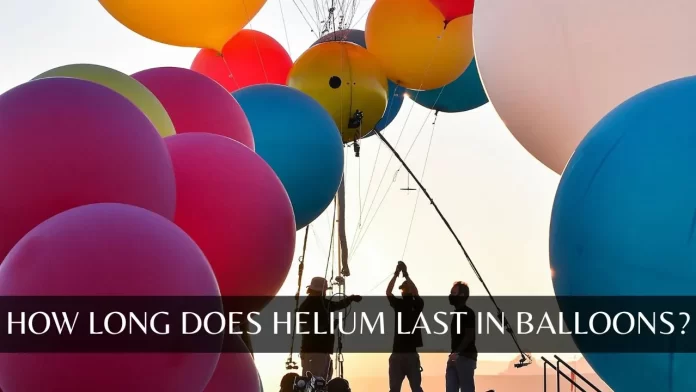Helium is a chemical element, represented by the symbol “He” on the periodic table, and is the second-lightest and second-most abundant element in the universe, after hydrogen. It is a colorless, odorless, and tasteless noble gas that exists in a gaseous state at room temperature and pressure.
Properties of Helium:
- Low Density: Helium is well-known for its low density, which means it is much lighter than the surrounding air. This property makes it valuable for various applications, including filling balloons.
- Non-Flammable: Helium is non-flammable, making it a safe choice for various uses where flammability is a concern.
Why Helium Is Used to Inflate Balloons:
Helium is commonly used to inflate balloons for several reasons:
- Buoyancy: As mentioned earlier, helium is less dense than air, so when it is used to fill a balloon, it makes the balloon buoyant. This buoyancy allows balloons to float in the air, creating an attractive and playful display.
- Safety: Helium is non-flammable, which makes it a safe choice for inflating balloons, especially those that may be near heat sources or open flames.
- Lightness: Helium-filled balloons are lightweight, making them easy to handle and carry. This characteristic is particularly advantageous for decorative purposes.
- Longevity: Helium-filled balloons tend to stay aloft for a more extended period compared to air-filled balloons. This makes them suitable for events or occasions where long-lasting decorations are desired.
- Novelty and Fun: Helium-filled balloons have a whimsical and fun quality due to their ability to float in the air. This makes them popular for celebrations, parties, and special events.
- Marketing and Advertising: Inflatable balloons with helium can be used for marketing and advertising purposes. They can carry messages or logos and are often used to draw attention to businesses or events.
Factors Influencing Helium Duration in Balloons:
The duration for which helium-filled balloons remain afloat can vary based on several factors. Understanding these factors can help you predict and maximize the longevity of helium-filled balloons:
- Balloon Size and Type:
- Larger balloons tend to stay aloft longer than smaller ones because they have more helium to provide lift.
- The type of balloon material can also affect how long helium lasts. Foil or Mylar balloons typically hold helium longer than latex balloons, which are more porous and allow helium to escape more quickly.
- Helium Purity: The purity of the helium used to inflate the balloons can impact how long they remain afloat. Higher-purity helium tends to provide better buoyancy and, therefore, longer float times.
- Ambient Temperature: The surrounding temperature can influence helium duration. Helium molecules move more slowly in cold temperatures, which can slow down the rate at which helium escapes from the balloon. Conversely, in hot weather, helium molecules move faster, causing helium to escape more quickly.
- Altitude: Balloons filled with helium will stay afloat longer at higher altitudes where the air pressure is lower. In locations at high altitudes, balloons can remain buoyant for an extended period compared to sea-level locations.
- Seal Quality: The quality of the seal on the balloon’s neck matters. If the seal is not airtight, helium can escape more rapidly, reducing the balloon’s float time.
- Balloon Overfilling: Overfilling a balloon with too much helium can lead to a shorter float time. Balloons need some flexibility to expand and contract with changes in temperature and air pressure. Overfilling can make them more prone to bursting.
- Air Pressure Changes: Changes in atmospheric pressure can impact helium-filled balloons. For instance, if you transport balloons from a lower elevation to a higher elevation, they may appear to lose buoyancy due to the lower air pressure at higher altitudes.
- Helium Purity: The purity of the helium used can influence float time. Higher-grade, purer helium tends to provide longer-lasting buoyancy.
- Humidity: High humidity levels can affect the float time of latex balloons. Helium molecules diffuse more quickly through latex in humid conditions, causing the balloon to lose helium faster.
- Balloon Seal and Handling:
- Properly tying or sealing the balloon’s neck is essential to prevent helium from escaping prematurely.
- Avoiding rough handling or sharp objects that can puncture the balloon is crucial for maintaining its float time.
Balloon Types and Durability:
- Latex Balloons:
- Material: Latex balloons are made from natural rubber latex or synthetic latex. They are porous and allow helium gas to slowly escape over time.
- Lifespan: The average float time for a latex balloon filled with helium is typically around 8 to 12 hours. However, this can vary based on factors like balloon size, helium purity, and environmental conditions.
- Special Considerations: Special coatings or treatments can extend the float time of latex balloons. Additionally, using a high-quality latex balloon and high-purity helium can help increase their longevity.
- Foil Balloons (Mylar Balloons):
- Material: Foil balloons, also known as Mylar balloons, are made from a metallic-coated polyester film. They have a non-porous surface that helps retain helium for a more extended period.
- Lifespan: Foil balloons filled with helium have a longer float time compared to latex balloons. On average, they can stay afloat for several days to a few weeks, depending on the quality of the balloon and environmental factors.
- Special Considerations: Foil balloons are often used for events that require longer-lasting decorations, such as birthday parties or promotional events. They are less likely to burst than latex balloons and can be easily refilled if they start to lose buoyancy.
- Bubble Balloons:
- Material: Bubble balloons are made from a stretchy, clear plastic material. They are known for their durability and ability to retain helium for an extended period.
- Lifespan: Bubble balloons filled with helium can remain afloat for several weeks, making them suitable for long-term decorations. They are often used for special occasions like weddings and anniversaries.
- Orb Balloons:
- Material: Orb balloons are spherical balloons made from a stretchy plastic material similar to bubble balloons.
- Lifespan: Orb balloons have a relatively long float time, often lasting for several weeks when filled with helium. Their unique shape and longevity make them popular for various events and celebrations.
- Qualatex Deco Bubbles:
- Material: Qualatex Deco Bubbles are a type of transparent, stretchy plastic balloon that can be filled with helium.
- Lifespan: These balloons are known for their extended float time and can stay inflated for several weeks. They are ideal for events that require long-lasting decorations.
Tips for Maximizing Helium Balloon Longevity:
To maximize the longevity of helium-filled balloons, whether they are latex or foil, follow these tips and best practices:
- Use High-Quality Balloons: Start with high-quality balloons. Well-manufactured balloons are less likely to have imperfections that can lead to helium leakage.
- Choose Foil Balloons (Mylar) for Longer Float Times: If you need balloons to stay afloat for an extended period, opt for foil balloons (Mylar). They generally retain helium longer than latex balloons.
- Use High-Purity Helium: Use helium gas with a high level of purity. High-purity helium provides better buoyancy and extends float times.
- Avoid Overinflating: Overinflating balloons can lead to premature bursting. Follow the manufacturer’s recommended inflation guidelines to ensure the proper size and float time.
- Avoid Underinflating: Balloons that are underinflated may not have enough helium to maintain buoyancy. Inflate them fully to the recommended size for better longevity.
- Handle with Care: Be gentle when handling helium-filled balloons to prevent damage or punctures. Sharp objects, rough surfaces, and sharp jewelry can cause leaks.
- Seal the Balloons Securely: Ensure that the necks of latex balloons are securely tied or sealed to prevent helium from escaping.
- Keep Balloons Indoors (If Possible): Outdoor conditions, such as wind and temperature fluctuations, can affect helium balloon longevity. Whenever feasible, use balloons indoors to extend their float time.
- Avoid Direct Sunlight and Heat Sources: Helium expands in the presence of heat, which can cause balloons to burst. Keep balloons away from direct sunlight, heaters, and other heat sources.
- Monitor Environmental Conditions: Changes in temperature and air pressure can impact helium balloons. Be aware of these conditions and adjust as needed to maintain float time.
- Helium Temperature: Store helium tanks in a cool place. Cold helium can cause balloons to shrink, but they will re-expand when brought to room temperature.
- Use Balloon Treatment Products: Consider using products specifically designed to extend the float time of latex balloons, such as balloon sealants or coatings.
- Refill as Needed: Foil balloons can often be refilled if they start to lose buoyancy. Check the manufacturer’s instructions for specific guidelines on refilling.
- Professional Inflation: If you’re planning a large event, consider having your balloons professionally inflated. Professionals have access to high-purity helium and can ensure consistent inflation.
- Plan Timing Wisely: Inflate helium balloons as close to the event time as possible to ensure they are at their peak float time during the celebration
Environmental Considerations:
- Wind:
-
- Impact: Wind is one of the most significant factors affecting outdoor helium balloons. Strong gusts of wind can cause balloons to drift or even pop if they come into contact with sharp objects or surfaces.
- Precautions:
- Secure Balloons: Use weights or balloon weights to anchor balloons to prevent them from drifting away.
- Cluster Balloons: Group several balloons together, tying them securely to a single anchor point or structure, to minimize the risk of individual balloons floating away.
- Choose a Sheltered Location: If possible, set up your balloon decorations in a sheltered or protected area to reduce exposure to strong winds.
- Sunlight and Heat:
-
- Impact: Sunlight and heat can cause helium to expand, which may lead to balloons bursting. Additionally, prolonged exposure to direct sunlight can cause the balloon material to weaken over time.
- Precautions:
- Shade Balloons: Place balloons in the shade or use a canopy or tent to provide protection from direct sunlight.
- Monitor Temperature: Be aware of the temperature, especially on hot days, as helium expands in heat. If necessary, release some helium to prevent overinflation.
- Choose Foil Balloons: Foil balloons are less affected by heat than latex balloons, making them a better choice for outdoor events in sunny conditions.
- Temperature Fluctuations:
-
- Impact: Rapid temperature changes can affect helium balloon float times. As temperatures drop, helium contracts, and balloons may lose some buoyancy.
- Precautions:
- Avoid Rapid Temperature Changes: If possible, avoid placing balloons in areas with extreme temperature fluctuations.
- Be Prepared: Be prepared to make minor adjustments, such as adding a bit more helium, if you notice balloons starting to lose buoyancy due to temperature changes.
- Rain and Moisture:
-
- Impact: Rain can cause latex balloons to deteriorate, and moisture can affect the float time. Water can also add weight to the balloons, making them more likely to fall.
- Precautions:
- Use Balloon Covers: Consider using balloon covers or plastic sleeves to protect latex balloons from moisture. Foil balloons are naturally more moisture-resistant.
- Remove Balloons if It Rains: If rain is expected, consider temporarily removing the balloons until the weather improves.
- Altitude:
-
- Impact: Balloons filled at higher altitudes may appear to have shorter float times because the lower atmospheric pressure can affect their buoyancy.
- Precautions:
- Inflate at the Event Location: Whenever possible, inflate helium balloons at the event location, especially if there is a significant difference in altitude.
Storage and Transport:
Here’s how you can ensure the longevity of helium balloons during storage and transportation:
- Deflate and Store Flat (For Latex Balloons):
- If you have latex balloons filled with helium that you wish to reuse, it’s essential to deflate them carefully. Here’s how:
- Gently release the helium by pressing the balloon’s neck near the knot.
- Slowly squeeze the balloon to release the remaining gas while gently folding it.
- Store the deflated balloon flat to prevent creases or wrinkles.
- Properly deflated latex balloons can be reused for future events.
- Keep Balloons Cool and Dry: Store balloons in a cool, dry place away from direct sunlight, moisture, and extreme temperature fluctuations. Exposure to heat and moisture can weaken the balloon material over time.
- Use Sealable Bags or Containers: Place deflated balloons in sealable plastic bags or airtight containers to protect them from dust and debris. Make sure the bags or containers are clean and dry before storing the balloons.
- Label and Date: If you have multiple sets of balloons, label the bags or containers with descriptions of the balloons and the date of the event. This will help you easily identify them when you want to reuse them.
- Prevent Tangling: To avoid tangling, consider placing individual balloons in separate bags or compartments within a larger storage container.
- Avoid Sharp Objects: When storing balloons, be cautious of any sharp objects or edges in the storage area that could puncture or damage the balloons.
- Consider Using Balloon Transport Bags: Balloon transport bags are designed specifically for transporting helium balloons. They have compartments and secure attachments to keep balloons in place during transit.
- Check for Leaks: Before storing or transporting helium balloons, check them for any small leaks or holes that may have developed during previous use. Repair any minor leaks with balloon repair adhesive.
- Reinflate When Needed: If you plan to reuse helium balloons in the future, you will need to reinflate them with helium before your next event. Ensure you have access to a helium tank or source when you are ready to use them again.
- Handle with Care During Transportation:
- If you need to transport helium balloons, do so with care to avoid damage or helium loss.
- Use large, sturdy boxes or containers to prevent balloons from being crushed during transit.
- Secure the balloons with balloon weights or other suitable anchor points within the transportation container to prevent them from floating around and potentially getting damaged.
In conclusion, understanding how to maximize the longevity of helium balloons through proper storage and transportation is crucial for anyone looking to reuse these festive decorations for future events. By following the guidelines outlined above, you can ensure that your helium-filled balloons remain in excellent condition and ready for use when needed.
FAQ
Q1: How long do latex helium balloons last?
Ans: Latex balloons generally last 8-12 hours, up to 2-3 days for larger ones.
Q2: How long do foil balloons last?
Ans: Foil balloons typically last 3-5 days, up to several weeks for larger sizes.
Q3: Can latex balloons withstand hot weather?
Ans: Latex balloons have a short lifespan in hot weather, lasting only 4-6 hours.
Q4: How do I make balloons last longer in hot weather?
Ans: Opt for foil balloons, under-inflate them, and use balloons with air temperature similar to outside.
Q5: What is the recommended size for shaped foil balloons?
Ans: For shaped foil balloons like numbers or alphabet characters, choose 24″ or larger for better floating.







